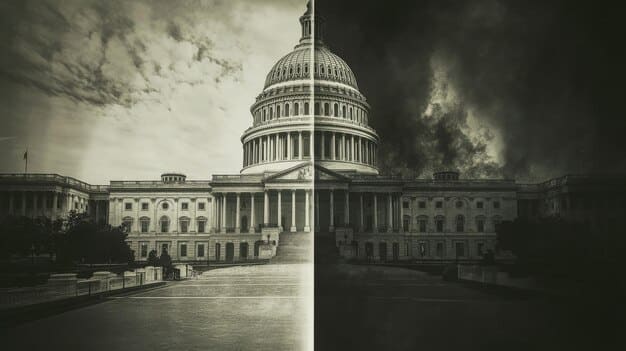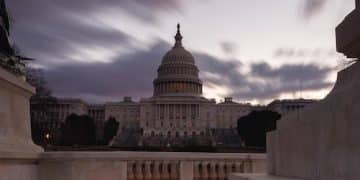National Debt Ceiling Debate: Economic Consequences Loom for US

The national debt ceiling debate is intensifying, raising concerns about potential economic consequences for the US, including possible default, market instability, and long-term economic repercussions.
The **national debt ceiling debate** has once again taken center stage in Washington, D.C., sparking fears and uncertainties about the future of the US economy. What are the potential consequences of this ongoing political battle?
Understanding the National Debt Ceiling
The debt ceiling is a limit set by Congress on the total amount of money the US government can borrow to meet its existing legal obligations. These obligations include Social Security and Medicare benefits, military salaries, interest on the national debt, tax refunds, and other payments. Once the debt ceiling is reached, the Treasury Department cannot issue new debt to pay these obligations.
What Happens When the Debt Ceiling Is Reached?
When the debt ceiling is hit, the Treasury Department must take extraordinary measures to prevent the US from defaulting on its obligations. These measures can include suspending certain investments, delaying payments, and prioritizing which bills to pay. However, these measures are temporary and can only delay the inevitable.
Historical Context of Debt Ceiling Crises
- 1995-1996 Standoff: Led to government shutdowns and heightened concerns about the US’s creditworthiness.
- 2011 Crisis: Resulted in a downgrade of the US’s credit rating by Standard & Poor’s and significant market volatility.
- 2013 Brinkmanship: Caused another government shutdown and raised fears of default, further damaging the US’s reputation.
The debt ceiling is not about authorizing new spending but rather about paying for spending that Congress has already approved. Failing to raise the debt ceiling would be akin to using a credit card and then refusing to pay the bill.
The Current Political Stalemate
The current political climate is marked by deep partisan divisions, making it challenging to reach a consensus on raising the debt ceiling. Republicans are demanding significant spending cuts in exchange for their support, while Democrats are hesitant to agree to cuts that could harm essential social programs.
Republican Demands for Spending Cuts
Republicans argue that the national debt is unsustainable and that spending cuts are necessary to rein in government spending. They are proposing cuts to a wide range of programs, including discretionary spending, entitlement programs, and foreign aid.
Democratic Stance on Protecting Social Programs
Democrats contend that spending cuts would disproportionately harm vulnerable populations and that investments in social programs are crucial for economic growth. They are proposing alternative solutions, such as raising taxes on the wealthy, to address the debt issue.

The political standoff is creating uncertainty and anxiety in financial markets, as investors worry about the possibility of a US default. The consequences of a default could be severe and far-reaching, affecting not only the US but also the global economy.
Potential Economic Consequences of Default
A default by the US government could have catastrophic consequences for the economy. It would undermine confidence in the US’s ability to meet its obligations, leading to higher interest rates, a decline in the value of the dollar, and a sharp contraction in economic activity.
Impact on Financial Markets and Interest Rates
A default would likely trigger a stock market crash and a surge in interest rates. Investors would demand higher yields on US Treasury bonds to compensate for the increased risk, driving up borrowing costs for businesses and consumers.
Effects on Government Payments and Social Security
The government would be forced to delay or suspend payments to Social Security recipients, Medicare providers, military personnel, and other beneficiaries. This would have a devastating impact on millions of Americans who rely on these payments for their livelihoods.
- Increased borrowing costs for the government, businesses, and consumers.
- A decline in consumer confidence and spending, leading to a recession.
- Damage to the US’s reputation as a reliable borrower, making it more difficult to attract foreign investment.
The economic consequences of a default would be felt across the board, affecting businesses, workers, and retirees alike. It could take years for the economy to recover from such a shock.
Historical Examples of Debt Crises
While a full-blown default by the US government would be unprecedented, there have been instances in other countries where debt crises have led to severe economic consequences. These examples provide valuable lessons about the potential risks of failing to address the debt issue.
The Greek Debt Crisis
The Greek debt crisis of 2010-2018 serves as a stark reminder of the potential consequences of unsustainable debt levels. The crisis led to a sharp contraction in the Greek economy, soaring unemployment, and a decline in living standards.
The Argentine Debt Crisis
Argentina has experienced multiple debt crises throughout its history, each of which has resulted in economic instability and hardship for its citizens. The country’s repeated defaults have eroded investor confidence and made it difficult to access international capital markets.

These historical examples underscore the importance of responsible fiscal management and the need to address the debt issue before it spirals out of control. Failure to do so could have devastating consequences for the economy and the well-being of the American people.
Potential Solutions and Negotiations
Finding a solution to the debt ceiling crisis requires compromise and a willingness to negotiate in good faith. There are several potential solutions that could be considered, including spending cuts, tax increases, and a combination of both.
Bipartisan Approaches to Fiscal Responsibility
A bipartisan approach would involve both Republicans and Democrats agreeing to a package of spending cuts and tax increases that would reduce the national debt over time. This would require both sides to make concessions and to put the interests of the country ahead of partisan politics.
Alternative Proposals and Economic Reforms
Other proposals include reforming the budget process, enacting a balanced budget amendment, and implementing policies that promote economic growth. These measures could help to address the underlying drivers of the national debt and to create a more sustainable fiscal path.
The longer the debt ceiling debate drags on, the greater the risk of economic damage. It is imperative that policymakers find a solution as quickly as possible to avoid a crisis that could have devastating consequences for the US and the global economy.
The Global Implications
The US economy is deeply integrated into the global economy, and a default by the US government would have far-reaching consequences for countries around the world. It could trigger a global recession, disrupt trade flows, and undermine confidence in the international financial system.
Impact on International Trade and Investments
A US default would likely lead to a decline in international trade and investment, as businesses and investors become more risk-averse. This would have a negative impact on economic growth in countries that rely on exports to the US.
Effects on Global Financial Stability
The US dollar is the world’s reserve currency, and a default would undermine its status as a safe haven. This could lead to a flight to other currencies and assets, creating instability in global financial markets.
The international community is closely watching the debt ceiling debate in the US, and a default would be a major blow to the country’s credibility and influence around the world. It is in the interest of all nations to ensure that the US resolves this issue in a timely and responsible manner.
| Key Point | Brief Description |
|---|---|
| ⚠️ Debt Ceiling | Limit on how much the US can borrow. |
| 📉 Default Risks | Can cause market instability and higher rates. |
| 🤝 Political Standoff | Republicans want cuts, Democrats want to protect programs. |
| 🌍 Global Impact | US default affects international trade and stability. |
Frequently Asked Questions (FAQ)
▼
The debt ceiling is the total amount of money that the United States government is authorized to borrow to meet its existing legal obligations, including Social Security, Medicare, and military salaries.
▼
If the debt ceiling is not raised, the US government would be unable to pay its bills, leading to a default on its obligations. This could cause significant damage to the economy.
▼
Potential solutions include spending cuts, tax increases, or a combination of both. A bipartisan agreement is needed to ensure a sustainable fiscal path for the country.
▼
The debt ceiling debate can create uncertainty in global markets. A US default could trigger a flight to safety and disrupt trade. Confidence in the US economy could diminish.
▼
Reaching a bipartisan agreement is challenging due to deep partisan divisions over spending priorities. Republicans and Democrats often have conflicting views on the role of government.
Conclusion
The national debt ceiling debate poses a significant threat to the US economy and the global financial system. Finding a solution requires compromise and a commitment to responsible fiscal management to avoid potentially catastrophic economic consequences.





